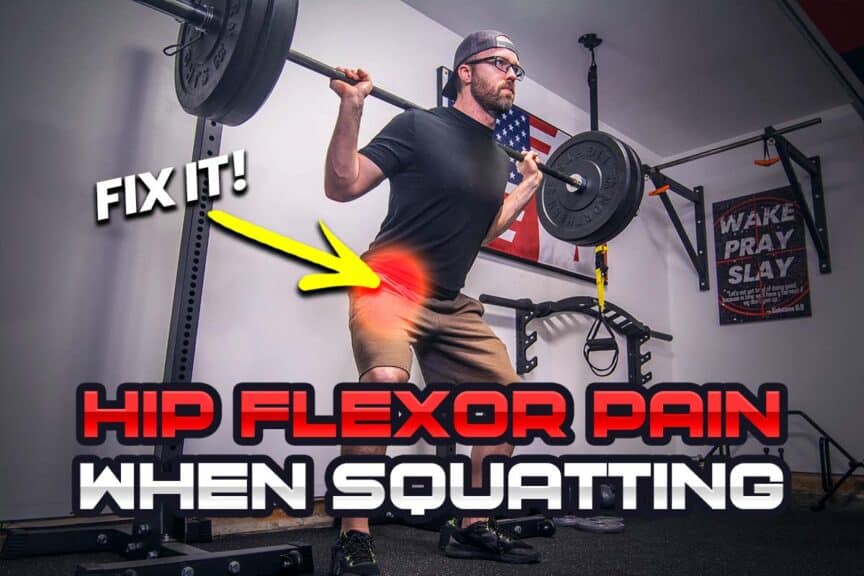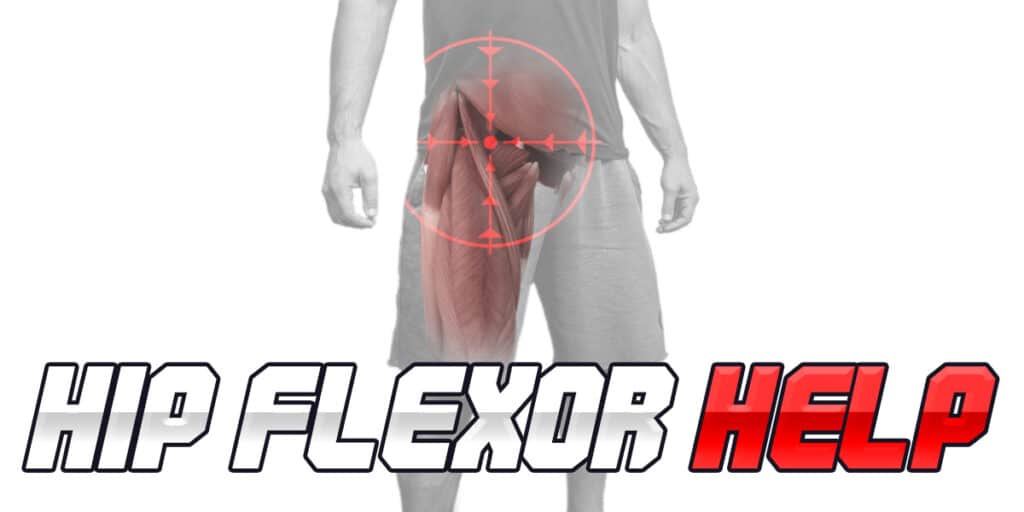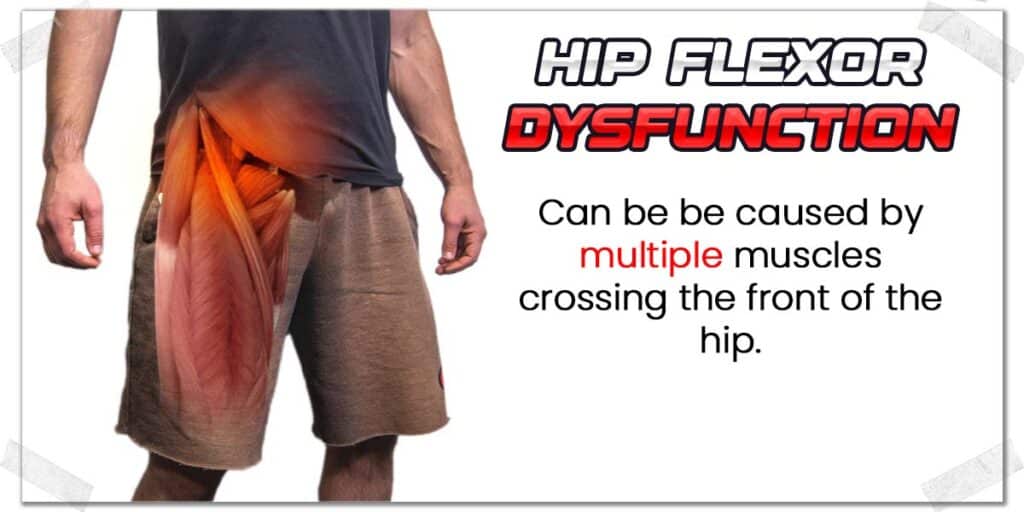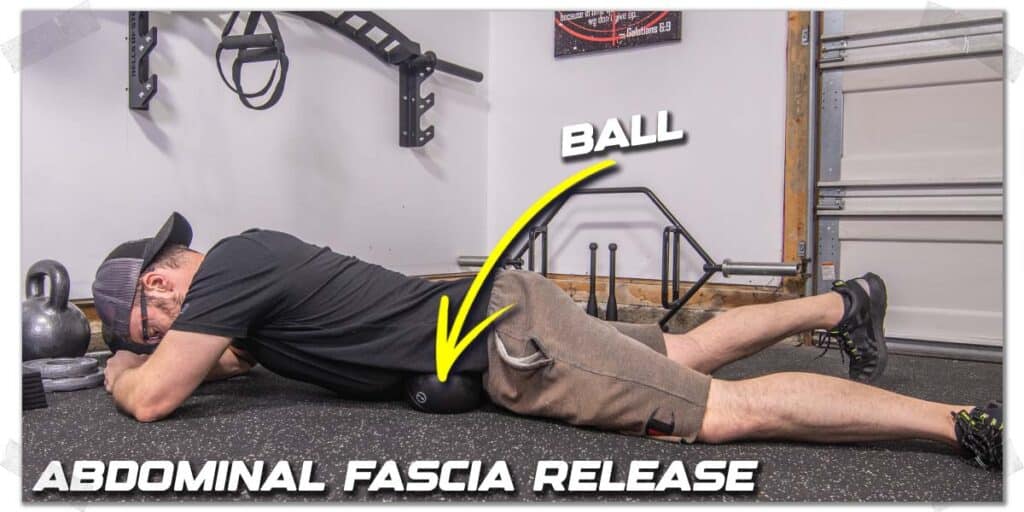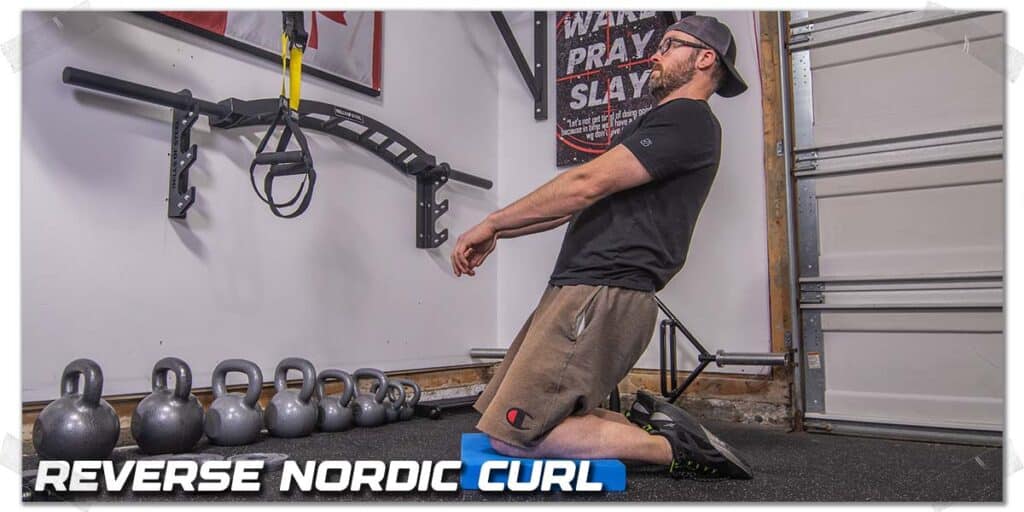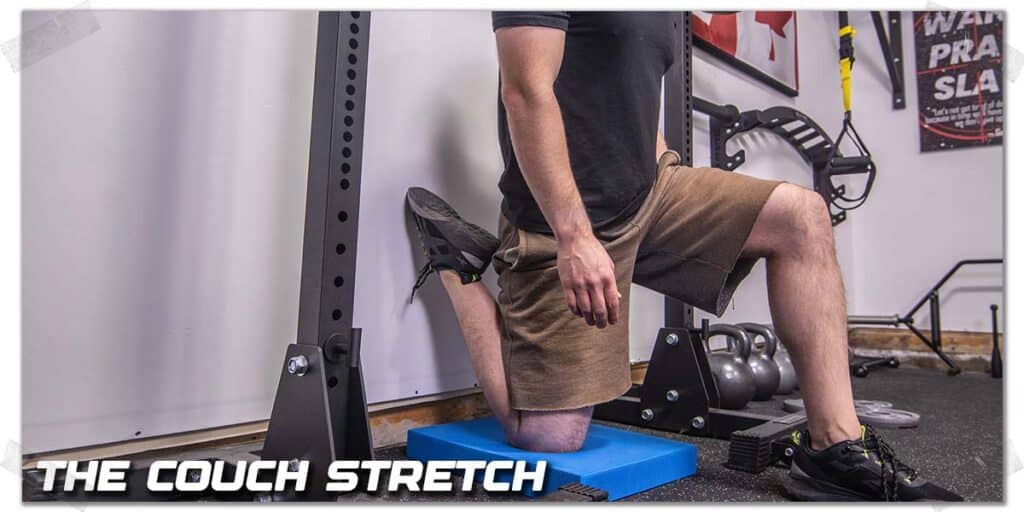Squats and squatting-based movements often comprise a significant portion of one’s strength training and exercise pursuits. And for good reason — these movements are necessary for developing stronger legs, more muscular endurance, and improved overall lower body performance.
But man, this is a hard thing to do when you experience hip flexor pain when squatting. So, finding a fix — and fast — is the name of the game.
That’s why, in this article, you’ll learn all about what causes hip flexor pain when squatting, why it could be a different issue instead, how to tell the difference, and most importantly, the common techniques I often give my patients and athletes to help them get back to pain-free squatting.
Alright, enough with the introduction; let’s get down to business!
A small request: If you find this article to be helpful, or you appreciate any of the content on my site, please consider sharing it on social media and with your friends to help spread the word—it’s truly appreciated!
Basic anatomy: hip flexor muscles, the hip joint, and hip cartilage
You very well may be dealing with pain arising from your hip flexor muscle when squatting—I’m not here to give you a diagnosis. But in addition to these muscles, I am here to help enlighten you with other muscles and anatomical structures of the hip that often cause pain and discomfort when squatting. Because chances are it’s not your hip flexor that’s causing your pain during the squat (though I haven’t evaluated you, so anything’s possible).
The hip and its associated structures are more complex and intricate than the average individual might otherwise realize. Because of this, it’s essential that I provide you with a brief and basic anatomical rundown of this region of the body.
The intention of doing this is not to try to impress you with my knowledge nor to overwhelm you with information. Instead, it’s a brief discussion worth having since it can help you understand what else might be arising in your hip and, most importantly, help you make sense of why specific interventions can be helpful in optimizing your hip health.
So, let’s take it from the top. I’ll keep it brief but effective. I promise.
Related article: Here’s Why Your Hips Ache After Working Out (and What to do About it)
Hip flexor muscles
In its most basic sense, a hip flexor muscle is any muscle that crosses the front side of the hip joint. Any muscle that does so will provide the body with the ability to bend the thigh, pulling it up towards the chest (this movement is known as hip flexion).
Some muscles are more optimized for this movement than others, and the main hip flexor muscles most people are referring to or thinking of when saying the word “hip flexor” is a combination of two muscles:
- The psoas major
- The iliacus
| Muscle | Origin | Insertion | Action |
| Psoas major | Transverse processes of L1-L5 | Lesser trochanter of femur | Flexes thigh at the hip joint, flexes trunk |
| Iliacus | Iliac crest, superior iliac fossa, anterior sacroiliac ligaments | Lesser trochanter of femur (via common tendon) | Flexes thigh at the hip joint, flexes trunk |
Indeed, these are the two powerhouse hip flexing muscles that produce the majority of strength and power for flexing the hip joint.
However, there are a couple of other hip flexing muscles that are briefly worth mentioning. They aren’t as optimized for producing hip flexion as the psoas and iliacus (collectively known as the iliopsoas muscle) but still assist with the movement and, as such, are prone to becoming painful in the same manner as the iliopsoas.
These additional hip flexing muscles are:
- The rectus femoris (one of the quadriceps muscles)
- The sartorius
- The tensor fascia lata
- The pectineus
- The adductor magnus
| Muscle | Origin | Insertion | Action |
| Rectus femoris | Anterior inferior iliac spine | Tibial tuberosity (via common quadriceps tendon and patellar ligament) | Flexes thigh at hip joint, extends leg at the knee joint |
| Sartorius | Anterior superior iliac spine | Medial aspect of proximal portion of tibia | Flexes & internally rotates leg at the knee joint, assists in flexion, abduction & external rotation of thigh at the hip joint |
| Tensor fascia lata | Anterior superior iliac spine & outer 1/3 of iliac crest | Tubercle of iliotibial tract on the tibia via iliotibial tract | Assists in internal rotation, abduction, and flexion of thigh at the hip joint |
| Pectineus | Superior pubic ramus | Pectineal line of femur | Abducts and flexes thigh at the hip joint |
| Adductor magnus | Inferior pubic ramus of ischium & ishial tuberosity | Gluteal tuberosity, linea aspera, medial supracondylar line, adductor tubercle | Adduction, flexes, and extends thigh at the hip joint |
Pro tip: Since the psoas major muscle attaches to the lumbar spine (the bottom five vertebrae, dysfunction arising from this muscle can often produce lower back pain on the side of the involved hip flexor.
Other tissues: Cartilage, capsules, and bursas
The human body is incredibly intricate and complex, and with so many different tissues and structures within the hip region, it’s important to realize there can be multiple tissues that generate pain — muscle is one type of tissue, but it is certainly not the only one.
Unhealthy hip cartilage
The hip joint itself is prone to becoming sore and painful, which often occurs due to irritated or degenerative cartilage (the smooth, shiny structure on the end of bones, which helps joints to slide and glide along other bones). This is known as osteoarthritis. It tends to be more common as we age, most often rearing its ugly head within the fourth and fifth decades of life and increasing in prevalence with each passing decade.
This is a tricky situation to deal with since unhealthy cartilage might not tolerate certain movements, so if you have any indications you’ve got an arthritic hip, it’s best to work with a qualified healthcare specialist to take the next steps forward.
Femoroacetabular impingement syndrome (FAI) and hip labrum issues
One other type of sneaky pain involving the cartilage of the hip that can arise when squatting is pain from the hip labrum. The labrum is a ring of fibrocartilage that runs around the perimeter of the socket, which acts to deepen and stabilize the articulation of the ball and socket joint.
For various reasons, the labrum can become irritated, often due to conditions such as femoroacetabluar impingement syndrome (FAI) or torn and painful from previous traumatic injury.
The result can be sharp, pinching-like pain in the hip when the hip flexes or bends in a manner that causes the labrum to get pinched or pulled in the process.
FAI is surprisingly common, and there are plenty of conservative measures that can be helpful for reducing and alleviating any pain arising from the condition. This often includes:
- Strengthening key muscles of the hip
- Modifying squat stance in a manner that reduces any hip impingement
- Modifying squat depth to avoid impingement
Working with a qualified physical therapist or other allied healthcare professional is a solid choice when dealing with FAI, as they will be able to help guide you along the path to recovery in an optimal manner.
Additionally, the labrum, which is a ring of cartilage that wraps around the hip socket (helping to increase hip stability and overall joint integrity) can become torn, sore, or irritated without the presence of FAI. These can be classified as hip labral disorders and can be quite painful at times.
Hip capsule stiffness
The hip capsule refers to a thick, leather-like tissue that covers the ball and socket joint of the hip. It helps provide stability to the joint while also housing synovial fluid, which is like a nutritional engine oil for the joint that keeps it lubricated and healthy.
The capsule can, at times, become stiff and fibrotic, which makes movement of the hip difficult or painful (or both). It’s actually a bit more common than what the average individual may realize.
Improving capsular mobility around the hip can be very beneficial for reducing or eliminating hip pain when performing squats (or other similar exercises).
A quick Google or YouTube search for hip capsule stretches can yield some promising content that may be worth exploring for improving hip capsule mobility (stretches, movements, positions, etc.).
The iliopectineal bursa
The human body is filled with over 200 bursas, which are little water balloon-like discs that reduce friction of tendons moving within the body. These little bursa sacs can become irritated and inflamed, and when this occurs, they can become painful, leading to a condition known as bursitis.
One particular bursa, known as the iliopectineal bursa, which sits directly in front of the common iliopsoas tendon, can become afflicted with bursitis, which typically produces sharp, sudden, and nasty pain in the low hip flexor region with activities that involve hip flexion (bending), such as squats, lunges, and running.
This can be a tricky issue to resolve, though it very often has good outcomes. It will likely require some activity modification and perhaps a higher-level intervention, such as a cortisone shot if it’s incredibly irritated.
Your best bet here to ensure a quick and optimal recovery is to work with a qualified healthcare professional, as they can help come up with modifications, strategies, and steps to take for optimizing your recovery as quickly and effectively as possible.
Related article: Injuries & Reclaiming Exercise Motivation (Practical Steps)
Helping the hip: Fixing hip flexor pain when squatting
So, now that you have the basic rundown on the general hip flexor region and some of the common causes of pain and dysfunction within the area, we need to come up with a few ways to get the issue under control. And don’t worry, I do this a lot with my patients.
The following strategies can be helpful for improving mobility of the hip flexor muscles. If you perform them, keep them on the gentle side and perform them frequently (multiple times per day, if possible). These strategies usually take some time, which requires patience and persistence, but the results can often be quite helpful.
Strategy 1: Targeting the abdominal fascia
The hip flexor (i.e., the psoas and iliacus) muscles are situated very deep within the abdominal cavity and are very hard to directly target. So, we’re using a bit of a workaround here.
While we can’t directly massage either of these muscles, we can target and mobilize some of the abdominal fascia (a connective tissue), which can help to relax or drop a bit of tone in the hip flexor – at least, in theory.
Anecdotally, this works well for me and many of my patients.
Here’s how to do it:
- With a semi-firm ball (about the size of a cantaloupe), lay on the floor and place the ball halfway between your belly button and the bony portion of the front of your hip (the anterior superior iliac crest, or ASIS, for short).
- Lay on the ball and breathe out, slowly sinking into the ball. You can lay still if this is intense enough, or you can slowly stir yourself around the ball and look for a few “spicy” spots (areas of discomfort) if needed.
- Keep the pressure of the ball on your abdomen for around a minute or two, then switch to the other side and perform for the other hip flexor.
Strategy 2: Perform the reverse Nordic curl
The reverse Nordic curl is a brilliant exercise for strengthening and lengthening your hip flexor muscles. It’s arguably my favorite exercise for these types of scenarios.
I’ve got a detailed article going over why it’s so outstanding and how to perform numerous progressions and regressions to fine-tune it so it fits your needs or abilities.
So, if you want to build some bulletproof hip flexors and eliminate hip flexor pain when squatting, check out the article:
Or, if you want, you can check out my YouTube video below!
Strategy 3: Perform the couch stretch
The couch stretch is a modification of the traditional hip flexor stretch, and I find it works best when you pulse it, meaning you gently push into the stretch for a few seconds, then reduce the stretch for a few seconds, and repeat.
Here’s how to do it:
- Place one knee on the ground (this will be the side you stretch your hip flexors) and place your foot up on a bench or against a wall (see photo).
- While keeping your hips pushed forward as far as possible, lean your body forward until you feel a gentle stretch in your hip flexor region. Hold this position for a few seconds, then back off and reduce the tension for a few seconds.
- Repeat this process for a couple of minutes, then repeat with your other side.
Final thoughts
There can be different reasons why your hip flexor hurts when squatting. Thankfully, there are plenty of strategies you can incorporate into your training to reduce or eliminate the issue.
Take some time to learn some of the basic hip anatomy discussed within this article, then take action! It might take some patience and persistence, but it will be well worth it! May your squats be heavy and pain-free!

Hi! I’m Jim Wittstrom, PT, DPT, CSCS, Pn1.
I am a physical therapist who is passionate about all things pertaining to strength & conditioning, human movement, injury prevention and rehabilitation. I created StrengthResurgence.com in order to help others become stronger and healthier. I also love helping aspiring students and therapists fulfill their dreams of becoming successful in school and within their clinical PT practice. Thanks for checking out my site!

